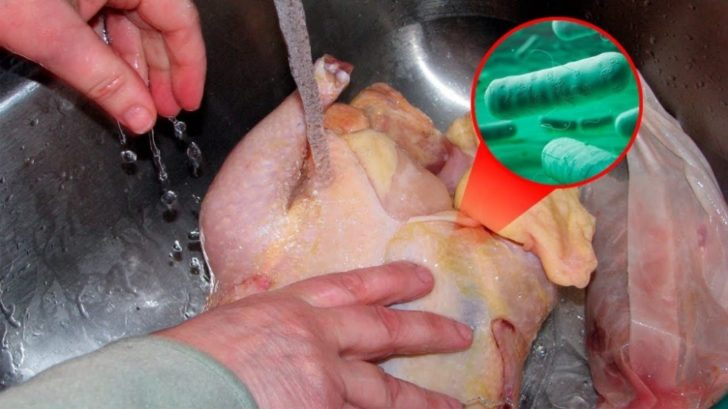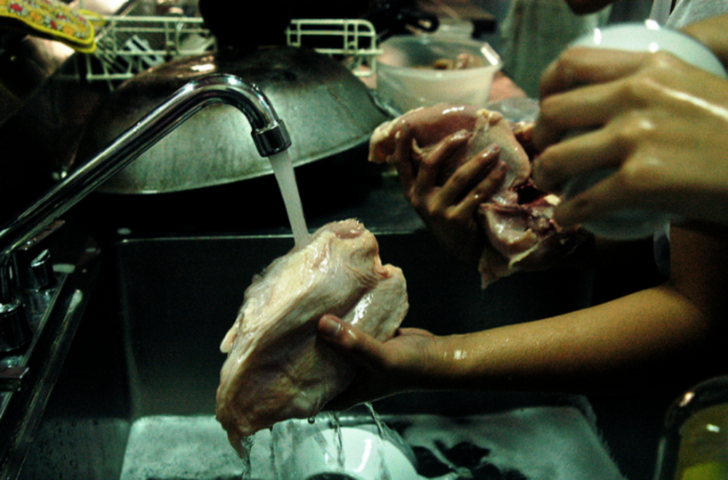In kitchens across the world, one common practice has been passed down through generations: washing raw chicken before cooking it. It’s a ritual many swear by, believing it’s the best way to clean the bird before seasoning and cooking. However, the Centers for Disease Control and Prevention (CDC) has recently stepped in with a clear message: Stop washing your raw chicken!
The CDC’s Official Stance on Washing Chicken
Why Washing Raw Chicken Is Dangerous

The CDC has made it clear that washing raw chicken does more harm than good. When you rinse chicken under the tap, you’re not just washing off any surface grime—you’re potentially spreading harmful bacteria like Campylobacter, Salmonella, and Clostridium perfringens all over your kitchen. These bacteria are notorious for causing foodborne illnesses, and they’re easily transferred from your chicken to other foods, utensils, and surfaces through the splash effect of water.
Invisible Threats: The Problem with Bacteria
One of the biggest issues with washing raw chicken is that you can’t see the bacteria you’re dealing with. Unlike dirt or dust, these microorganisms are invisible to the naked eye, making it impossible to know when and where they’ve spread. Even a small droplet of water containing these bacteria can travel far, contaminating nearby surfaces and putting your health at risk.
Understanding the Risks: What Are Campylobacter and Salmonella?
Campylobacter: A Leading Cause of Food Poisoning
Campylobacter is one of the most common causes of food poisoning in the United States, and raw poultry is a primary source. Ingesting this bacteria can lead to symptoms like severe stomach cramps, fever, vomiting, and diarrhea within just two to five days of exposure. The CDC estimates that about 1.5 million Americans are affected by Campylobacter each year.
Salmonella: A Persistent Kitchen Hazard
Salmonella is another dangerous bacterium commonly found in raw chicken. It’s responsible for countless food recalls and can cause serious gastrointestinal issues. In severe cases, especially in vulnerable populations such as the elderly or those with weakened immune systems, Salmonella can lead to life-threatening complications.
Why Cooking Is Key: The Proper Way to Kill Bacteria
Cooking Chicken Thoroughly
Don’t wash your raw chicken! Washing can spread germs from the chicken to other food or utensils in the kitchen. https://t.co/QlFpd1alG3 pic.twitter.com/bLB1ofcuh7
— CDC (@CDCgov) April 26, 2019
The CDC emphasizes that the best way to kill harmful bacteria on chicken is through proper cooking, not washing. When chicken is cooked to an internal temperature of 165°F (75°C), any bacteria present are effectively eliminated. This is the safest and most reliable method to ensure your food is free from pathogens.
Why Washing Isn’t Necessary
The idea that washing chicken removes bacteria is a common misconception. In reality, washing does little to clean the meat and does nothing to kill bacteria. Instead, it only increases the risk of spreading these harmful microorganisms around your kitchen.
The Controversy: Why Some People Still Wash Their Chicken
Traditional Practices vs. Modern Science

Despite the CDC’s warnings, many people continue to wash their chicken, often citing traditional methods passed down through generations. For some, it’s a deeply ingrained habit, often involving a rinse with lemon juice or vinegar, which they believe helps to clean the meat.
Public Reactions to the CDC’s Guidelines
The CDC’s advice has been met with mixed reactions. Some people are willing to change their habits in light of the new information, while others remain skeptical. Social media platforms have seen debates where individuals defend their practices, often with comments like, “I’ve always done it this way and never had a problem.”
Cleaning Up: The Right Way to Handle Raw Chicken
Safe Handling Practices

If you’re concerned about cleanliness when handling raw chicken, focus on proper kitchen hygiene rather than washing the meat. Always wash your hands with soap and water after handling raw chicken, and make sure to sanitize any surfaces, cutting boards, and utensils that have come into contact with it.
Preventing Cross-Contamination
To further reduce the risk of cross-contamination, use separate cutting boards for raw meat and other foods like vegetables or bread. After preparing chicken, thoroughly clean and disinfect all surfaces and tools that were used.
Conclusion
The CDC’s recommendation to stop washing raw chicken before cooking is based on sound science and aims to prevent the spread of dangerous bacteria in your kitchen. While it may feel counterintuitive to some, understanding the risks associated with washing chicken can help you adopt safer practices in food preparation. By focusing on proper cooking and kitchen hygiene, you can ensure that your meals are both delicious and safe to eat.


